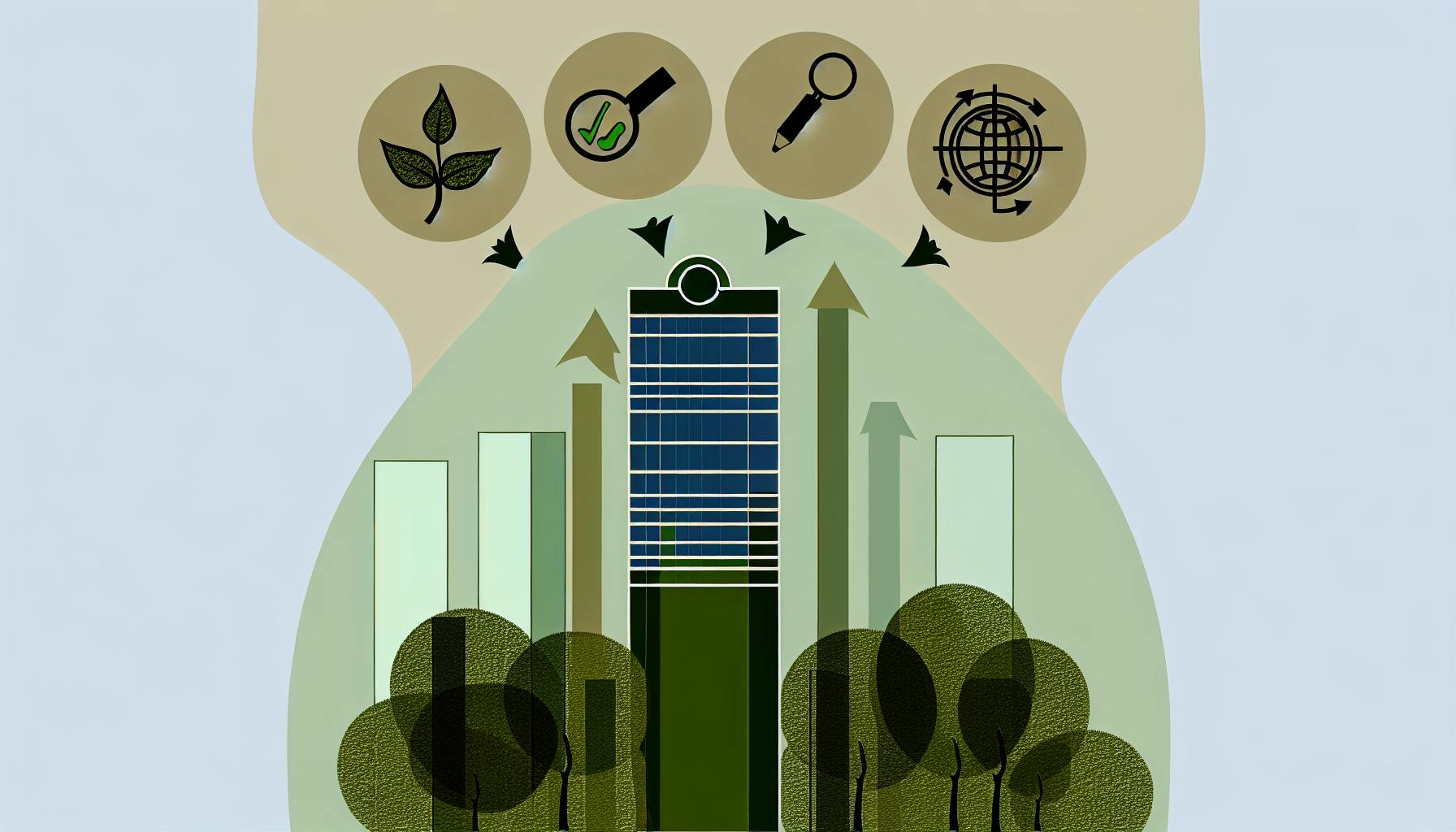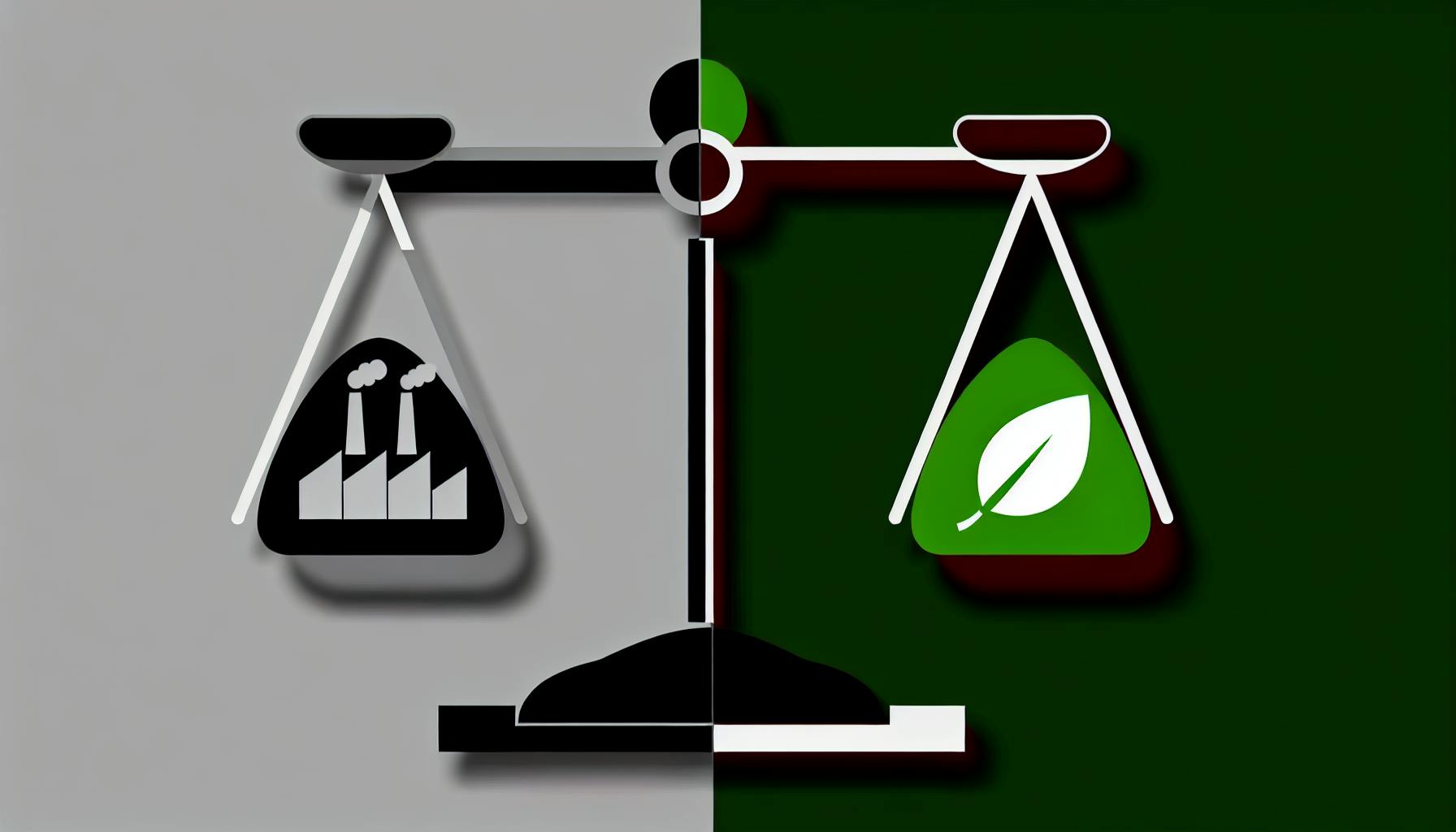Green logistics training is essential for companies looking to make their supply chains more eco-friendly without sacrificing profits. Here's what you need to know:
- Green logistics aims to reduce environmental impact through fuel efficiency, waste reduction, and eco-friendly packaging
- Proper training is crucial for successful implementation
- 7 key components of green logistics training:
- Sustainable supply chain basics
- Environmental rule compliance
- Green transportation methods
- Eco-friendly warehousing and packaging
- Green purchasing and supplier relations
- Carbon footprint measurement and reduction
- Green logistics tech
Quick comparison of green logistics components:
| Component | Focus Area | Key Benefit |
|---|---|---|
| Supply chain basics | Overall sustainability | Balanced approach |
| Rule compliance | Environmental laws | Avoid fines, maintain reputation |
| Transportation | Efficient routing, clean vehicles | Reduced emissions |
| Warehousing/packaging | Energy efficiency, eco-materials | Lower costs, less waste |
| Purchasing/suppliers | Green practices, collaboration | Reduced supply chain emissions |
| Carbon footprint | Measurement, reduction strategies | Meet sustainability targets |
| Technology | IoT, AI for optimization | Improved efficiency |
By implementing these training components, companies can lead in sustainability while improving their bottom line.
Related video from YouTube
Basics of Sustainable Supply Chain Management
Sustainable supply chain management is about making your logistics eco-friendly without hurting profits. It's a balancing act between making money and protecting the planet.
Balancing Profit and Planet
Think going green means losing money? Not always. Here's how to make it work:
- Use recycled packaging
- Plan smarter routes to save fuel
- Help suppliers go green
Toyota's doing it. They've switched to 100% renewable electricity in European plants and some in South America. Result? Lower emissions AND lower energy costs.
Being a Good Corporate Citizen
It's not just about the environment. Social responsibility matters too:
- Treat workers fairly
- Follow local laws
- Support communities
Mars took action. They reduced their number of mills to keep a closer eye on environmental practices. They even use satellites to watch for deforestation.
"Sustainability is no longer about doing less harm. It's about doing more good." - Ray Anderson
Customers care. 80% think sustainability is important, and 60% will change how they shop to help the environment.
2. Following Environmental Rules
Logistics companies must navigate a maze of environmental laws. Why? To dodge fines, keep their reputation intact, and run smoothly.
Key Environmental Laws
Here's the lowdown on the big ones:
- Clean Air Act (CAA): Caps air pollution. Impacts vehicle use and warehouse ops.
- Clean Water Act (CWA): Guards water quality. Mandates wastewater treatment.
- CERCLA: Tackles hazardous waste cleanup. Companies can be on the hook for releases.
- EPCRA: Requires yearly chemical inventory reports.
How to Stay Compliant
Want to keep your logistics company on the right side of these laws? Here's how:
- Tap expert knowledge: Environmental consultants can uncover cost-effective compliance strategies.
- Stay in the loop: Laws change. Keep your finger on the pulse.
- Embrace green tech: Cut emissions and energy use with new tech.
- Vet your partners: Make sure suppliers play by the rules too.
- Educate your team: Regular training keeps everyone on the same page.
- Get the green stamp: ISO 14001 certification shows you mean business when it comes to environmental rules.
3. Green Transportation Methods
Let's dive into two key ways to make shipping greener:
Planning Better Routes
Smart route planning can slash fuel use and emissions. Here's the scoop:
- Use route optimization software like EasyRoutes. It can cut emissions by up to 17%.
- Dodge traffic and idling. Less time stuck means less wasted fuel.
- Pack those trucks full. Fewer trips = lower emissions.
Using Cleaner Vehicles
Eco-friendly vehicles are a game-changer:
| Vehicle Type | What's Good | Who's Doing It |
|---|---|---|
| Electric Vehicles | 6x less CO2 per km, 80% energy efficient | La Poste drove 30 million km, cutting CO2 and noise |
| Hybrid Trucks | 30% more fuel efficient, 30% less emissions | Coca-Cola ordered hundreds |
| Biodiesel Trucks | Cleaner than standard diesel, works in existing engines | Many companies testing blends |
Some big names are stepping up:
FedEx runs 408 alternative fuel trucks. They saved 276,000 gallons of fuel and cut 2,800 metric tons of CO2.
Carrefour teamed up with Renault Trucks to add electric trucks to their fleet.
"Full lifecycle usage data from EVs will become the most valuable asset for OEMs and their partners." - Sebastian Scharfenberger, SAP
Green transportation isn't just good for the planet. It's smart business.
4. Green Warehousing and Packaging
Green warehousing and packaging are crucial for eco-friendly logistics. Here's how to make warehouses more energy-efficient and improve packaging choices:
Energy-Saving Warehouse Design
Warehouses are energy hogs. Making them greener cuts costs and helps the environment. Here's how:
1. Lighting
Switch to LEDs. They use 30-70% less power than traditional lights and last longer.
| Lamp Type | Electricity Used (kWh/year) | Annual Savings ($/year) |
|---|---|---|
| Ceramic Metal Halide | 1,105 | 127 |
| Six-Lamp T8 Fluorescent | 1,060 | 137 |
| LED | 775 | 170 |
| LED with Controls | 388 | 209 |
Based on 5000 hours/year at $0.10/kWh
2. Heating and Cooling
Use big, slow fans (HVLS) to circulate air. This can slash energy use by 30%. Add good insulation and smart HVAC systems that run only when needed.
3. Power
Slap some solar panels on the roof. They can cover up to 20% of a warehouse's power needs.
4. Equipment
Ditch gas forklifts for electric ones. They're cleaner and quieter.
5. Smart Systems
Get a Warehouse Management System (WMS) to track energy use and spot savings opportunities.
Eco-Friendly Packaging
Packaging protects products but creates waste. Here's how to green it up:
- Use Less: Right-size packages and cut out extra wrapping.
- Choose Better Materials: Opt for biodegradable or recyclable materials.
- Work with Suppliers: Get them on board with green packaging too.
- Reuse and Recycle: Set up systems to reuse materials and make recycling easy for customers.
sbb-itb-919600f
5. Green Buying and Supplier Relations
Green buying and eco-friendly suppliers are crucial for green logistics. Here's how to nail it:
Checking Supplier Green Practices
To pick green suppliers:
- Check eco-certifications (ISO 14001)
- Measure carbon footprint
- Assess waste management
- Look at renewable energy use
- Review packaging choices
Use a scorecard to rate suppliers. It's fair and easy.
Teaming Up for Green Goals
Once you've got green suppliers, work together to green the whole supply chain:
- Set shared eco-goals
- Share green tech and methods
- Cut waste together
- Help suppliers measure impact
Patagonia's a great example. They work with suppliers to use less water and fewer harmful chemicals in clothes dyeing.
"We've partnered with suppliers to test natural dyes at scale. It uses less water and eliminates nasty chemicals", says Patagonia's supply chain head.
Here's the kicker: Your supply chain emissions are often WAY higher than your own. The Science Based Targets initiative (SBTi) found supply chain emissions are typically 11 times more than a company's direct emissions.
So, greening your suppliers? It's not just nice. It's NECESSARY.
6. Measuring and Cutting Carbon Footprints
How to Measure Carbon Footprints
Measuring carbon footprints in logistics is crucial. Here's how:
1. Understand emission scopes
- Scope 1: Direct emissions from company-owned sources
- Scope 2: Indirect emissions from purchased energy
- Scope 3: All other indirect emissions, including supply chain
2. Collect data
Gather info on fuel use, electricity consumption, and supply chain activities.
3. Use carbon accounting software
Tools like Sweep and Watershed automate data collection and analysis.
4. Apply calculation methods
| Method | Description | Best For |
|---|---|---|
| Primary data | Uses actual fuel consumption, distance traveled, etc. | Most accurate results |
| Default data | Uses emission factors based on historical data | When primary data isn't available |
| Spend-based | Calculates emissions based on financial value of purchases | Quick estimates |
| Supplier-specific | Collects product-level data from suppliers | Detailed supply chain analysis |
5. Follow recognized frameworks
Use the GLEC framework or GHG Protocol for consistent reporting.
Ways to Cut Emissions
Ready to shrink your footprint? Try these:
1. Optimize transportation
- Plan better routes
- Use cleaner vehicles
- Cut idle times
2. Boost supply chain efficiency
- Team up with suppliers to cut their emissions
- Go local when possible
3. Upgrade tech
- Use real-time tracking
- Try load optimization software
4. Set clear targets
Aim for specific KPIs like emissions per mile or per unit of product.
5. Get everyone involved
- Train staff on green practices
- Work with suppliers on emission reduction goals
Small changes add up. FedEx saved 53 million gallons of fuel in one year by tweaking aircraft loading and flight plans.
"Supply chain decarbonization will be a 'game changer' for the impact of corporate climate action." - Nigel Topping, High-Level Climate Action Champion for UNFCCC
7. New Tech for Green Logistics
IoT and AI in Logistics
IoT and AI are revolutionizing logistics, making it greener.
IoT devices connect and share data, helping companies track goods, find better routes, cut fuel use, and reduce waste. AI takes this data and makes smart choices like picking the best routes, predicting issues, and optimizing fuel use.
Here's what IoT sensors on trucks can track:
| Data Point | Use |
|---|---|
| Fuel use | Save gas |
| Speed | Plan routes |
| Temperature | Keep goods fresh |
AI uses this info to streamline operations and reduce environmental impact.
Success Stories in Green Tech
Real companies are using these tools to make big changes:
Pirelli: Sensors on production lines catch bad tires early, keeping them out of landfills.
Hydromesh: AI maximizes local green energy in smart grids.
Planted: Software tracks and cuts CO₂ emissions, following the GHG protocol.
Arcadia: Arc software simplifies complex energy data for customers, making solar power more accessible.
These examples show how new tech is greening logistics. As more companies jump on board, we'll see even bigger changes in global goods movement.
How to Run Green Logistics Training
Creating Useful Training Programs
To make green logistics training work, focus on your company's goals. Look at what you're doing now and where you can do better. Then, build your training around those areas.
Here's how to create a good program:
- Set clear goals
- Tailor training to different jobs
- Use varied teaching methods
- Keep lessons short and engaging
- Include company-specific examples
GoBolt, for instance, trains staff on electric vehicle use. They want most local deliveries to be electric by 2025. Their training covers using and maintaining electric trucks, supporting their green goals.
Checking if Training Works
After training, you need to know if it's helping. Here's how to check:
- Surveys: Ask staff what they learned and how they're using it
- Tests: Quick quizzes on key points
- Observation: See if staff use new green methods
- Track metrics: Monitor fuel use or recycling rates
| What to Check | How to Check It |
|---|---|
| Knowledge | Quizzes, surveys |
| Behavior | Observation, feedback |
| Results | Fuel use, waste reduction |
Planted uses software to track CO₂ emissions, showing if training leads to lower emissions over time.
"By training and motivating employees, companies can create a workforce that actively participates in sustainability efforts." - Thomas Hellmuth-Sander
Don't forget to:
- Celebrate good results
- Keep training current with new green tech and methods
- Ask staff for improvement ideas
Problems and Fixes in Green Logistics Training
Helping People Accept Change
Shifting to green logistics often faces pushback. Here's how to tackle it:
1. Show the benefits
Explain how green practices help both the company and the environment. Take Maersk's approach: they teamed up with suppliers on energy-efficient solutions. This built trust and showed real commitment.
2. Talk about costs
People worry about high upfront costs. Show them the long-term savings and suggest starting small. For example, optimize routes before buying electric vehicles.
3. Build a support network
Get everyone working together - across departments and with suppliers. Novo Nordisk did this well. They trained suppliers, focusing on clear communication and shared wins.
4. Walk the talk
When leaders use green practices, others follow. It's that simple.
Keeping Training Fresh
Green standards change fast. Here's how to keep up:
1. Update regularly
Look at your training materials yearly. Add new laws, tech, and company goals.
2. Use real examples
Share success stories from your company or industry. It makes training stick and shows real impact.
3. Ask for feedback
Find out what your trainees need. Use surveys or focus groups to spot knowledge gaps.
4. Stay in the loop
Join industry groups, go to conferences, and follow green logistics news. It's the best way to stay current.
Wrap-Up
Green logistics training covers seven key areas:
- Sustainable supply chain basics
- Environmental rules
- Green transportation
- Eco-friendly warehousing and packaging
- Green buying and supplier relations
- Carbon footprint measurement and reduction
- New tech for green logistics
The future of green logistics? It's booming. The market's expected to hit $2.9 trillion by 2032, growing 8.3% yearly. 81% of global shippers are now more focused on sustainability than three years ago. And urban last-mile delivery? It could grow by 78% by 2030, pushing for greener solutions.
So, what should companies do?
- Set clear goals. One Food and Beverage/Retail Supply Chain Director puts it this way: "We plan to have 40% less CO2 Emissions by 2023 and replace legacy fleet with alternative vehicles."
- Team up. Work with suppliers on green projects, like Maersk did.
- Embrace tech. Use AI and IoT to boost efficiency and cut waste.
- Keep learning. Join industry groups and stay on top of green logistics news.
The green logistics train is leaving the station. Are you on board?



